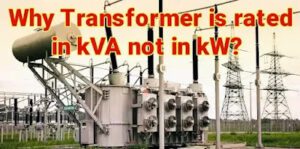A transformer is a static electrical device that transfers electrical power from one circuit to another circuit without changing its frequency and power. The main function of a Transformer is to step-up or step-down the value of voltage and current keeping power and frequency constant.
Why Transformer is rated in kVA, not in kW?
As we know, Any electrical equipment is rated based on its current handling capacity at a particular voltage and the losses occurring in it. Similarly, Transformers are also rated based on the maximum power that can transfer from primary to secondary considering losses into account.
Actually, There are two reasons behind the rating of Transformer in kVA instead of kW. So let’s discuss it in detail, Why transformer is rated in kVA, not in kW?
The primary reason the transformer is rated in kVA, not in kW is that at the time of designing of Transformer, the manufacturer didn’t have any idea about which type of load (either Inductive, capacitive, or resistive load) would be connected to it in working condition. Since the load power factor is not known at the time of manufacturing, So transformer is rated in kVA by considering pure resistive load (PF = 1).
Read More: Why CT secondary should not be open-circuited?
If the load will be either (Inductive+resistive) or (Capacitive+resistive) or (mixed RLC) then some part of the power will supply reactive power (VAR) and the remaining will supply Active power (Watt) to the load. However, the total apparent power (VA) supplied by the transformer will still be a vector sum of VAR and Watt. Hence transformer will be able to supply both real and reactive power to the load, that’s why the transformer is rated in kVA instead of kW.
For example, Consider a load of induction motor (RL load) that has windings that are Inductive and also possess some resistance. Thus, It will draw both active power (kW) and reactive power (kVAR) so that the total apparent power (kVA) drawn by the motor will be phasor sum of kW and kVAR. Also, the current drawn by the load depends on its power factor, which is not known to the manufacturer at the time of design. Hence due to this reason, the transformer is rated in kVA instead of kW so that it can be used for any type of load.
One of the other reasons for Rating of Transformer in kVA instead of kW is Power losses in the transformer. Since the rating of the Transformer is dependent on the temperature rises, which depends upon the losses in transformer. However, the temperature can be maintained within the permissible limit by using a proper cooling system. For a given cooling system, the rating of Transformer directly depends on the losses occurring in the transformer.
In a transformer, there are two types of losses:
- Copper losses or I2R losses: depends on I
- Core losses or Iron losses: depends on V
Since copper losses depend on current (I) and core losses or iron losses depend on voltage (V), hence total losses of the Transformer depend on Volt-Amp (VA) only and not on the power factor of the load. That’s why transformer is rated in kVA, not in kW.
|
Important Note: The simple way to know which devices are rated in kVA and which are rated in kW is:
|
- Causes, effect and protection of Earth fault
- What is DI, DO and AI, AO?
- Difference between Volts and Ampere
- What are different types of Electrical load
- Different types of Electricity Tariff
- What is Transducer?
- Meaning and significance of 1 unit electricity
- What is core balance current transformer (CBCT)
- Flaming’s left-hand and Right-hand rule
- Why CT secondary should not be open-circuited?

